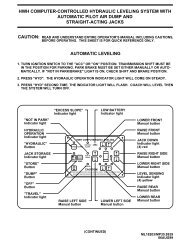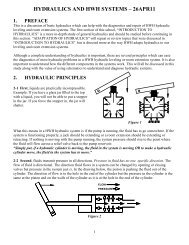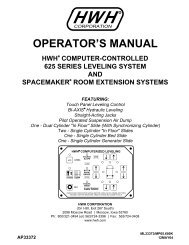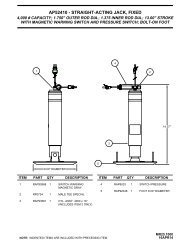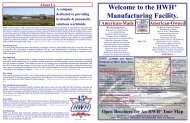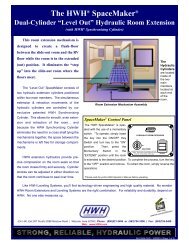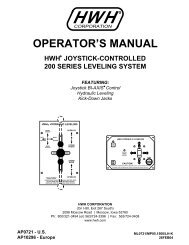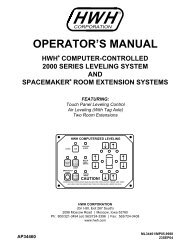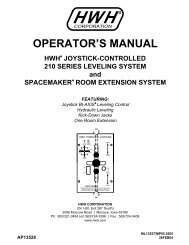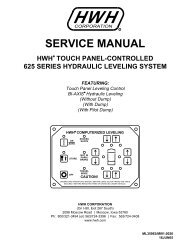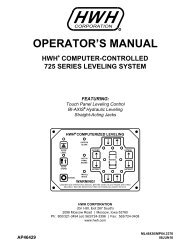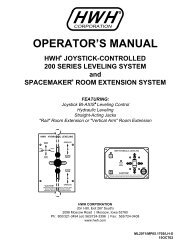AIR SUSPENSIONS AND HWH - HWH Corporation
AIR SUSPENSIONS AND HWH - HWH Corporation
AIR SUSPENSIONS AND HWH - HWH Corporation
- No tags were found...
You also want an ePaper? Increase the reach of your titles
YUMPU automatically turns print PDFs into web optimized ePapers that Google loves.
Push-in fittings. Push-in fittings make installation and removal of air lines easier. There is no tighteningprocedure to secure and seal the air line. The push-in fittings are reusable. To install an air line, make surethe end of the line has a good square cut. When cutting the line, it is best to use a good scissor type tubecutter to prevent the line from being crushed while cutting. Push the line into the fitting until it bottomsout. Pull back on the line to make sure it is locked in place. To remove the line, push the locking ringtoward the main body of the fitting then pull the line from the fitting. It will be easier to remove the air lineif the air pressure is removed from the circuit. When removed, the end of the line will show some gripmarks. It is best to cut off enough line to remove these grip marks. If the grip marks are not removed, theconnection may leak.3-2.3.4 Air manifold check valves. Standard air manifolds have a right and left check valve. The checkvalves perform two functions. They prevent air from flowing from the high pressure air bag to the lowpressure air bag when both raise valves on the manifold are opened. They also prevent air from flowingfrom the air bag back to the air supply when a raise valve is opened. To date, I know of no air manifoldcheck valve ever being replaced.3-2.3.5 Travel by-pass T-handle. The by-pass T-handle is not on all air manifolds. The T-handle wasadded as an aid to the vehicle manufacturers. When open, air from the height control valve by-passes thetravel valve and is directed to the air bag. This allows the vehicle manufacturer to use shop air to keep thevehicle at ride height during the manufacturing process without having to energize the travel solenoidvalves. The only real problem the T-handle has caused is the manufacturer will sometimes forget to closethe T-handle when production of the vehicle is complete. If a T-handle is open, any time the vehicle israised, lowered or leveled, any corner with an open T-handle will return to ride height, depending onavailable air supply. The by-pass T-handles should not be used as an emergency by-pass by thevehicle operator. Most air manifolds are mounted under the vehicle in areas with limited access. Turningthe T-handle will cause the vehicle to move up or down which will be a hazard to anyone under thevehicle.WARNING: DO NOT CRAWL UNDER A VEHICLE UNLESS THE FRAME OF THE VEHICLEIS PROPERLY SUPPORTED. DO NOT USE THE <strong>AIR</strong> SUSPENSION OR LEVELING JACKSTO SUPPORT THE VEHICLE WHILE UNDER THE VEHICLE.Page 17 – 22JUL09



